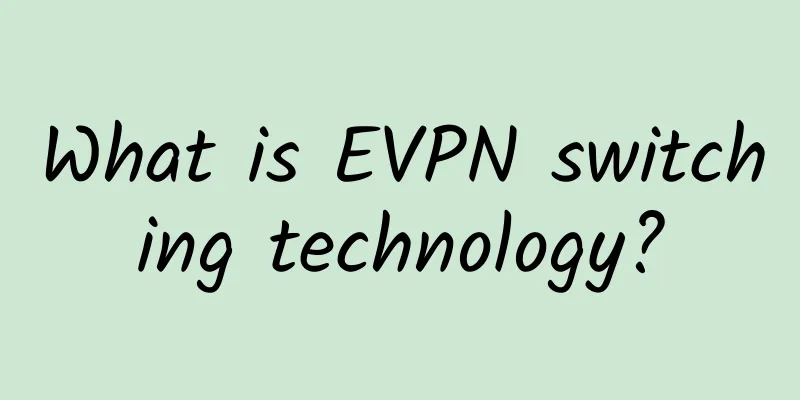What is EVPN switching technology?

|
In an evolving network landscape, the need for faster, scalable, and future-proof solutions is at an all-time high. As businesses continue to expand their digital footprint, the need for a robust network infrastructure becomes increasingly important. In the quest for network excellence, one technology that stands out is Ethernet Virtual Private Network (EVPN) switching. This technology not only solves current network challenges, but also lays the foundation for future-proof networks. What is EVPN switching?Ethernet Virtual Private Network (EVPN) is an advanced network technology designed to address the challenges of traditional Ethernet networks and provide greater flexibility, scalability, and efficiency. EVPN operates as an overlay network, introducing new concepts and capabilities to enhance the way devices communicate across geographically dispersed locations. At its core, EVPN is designed to improve communication and interaction between devices in a network, and it does this by merging Layer 2 (L2) and Layer 3 (L3) network service elements. This combination of Layer 2 and Layer 3 capabilities makes EVPN a versatile and adaptable solution for the needs of modern networks. Key elements of EVPN switchingOverlay Network: EVPN introduces the concept of overlay networking, which creates a virtual network on top of the existing physical infrastructure. This overlay allows more efficient communication between devices regardless of their physical location. Versatility of Layer 2 and Layer 3 services: One of the outstanding features of EVPN is its support for Layer 2 and Layer 3 services. In traditional networks, these two layers usually operate independently, which brings challenges when integrating different services. EVPN seamlessly integrates Layer 2 and Layer 3 services to create a more unified and efficient network architecture. MAC and IP address learning: EVPN uses a mechanism to learn media access control (MAC) addresses and Internet Protocol (IP) addresses. This allows devices within the network to discover and communicate with each other more efficiently. The network understands the location of the device and can make intelligent decisions on how to forward traffic. BGP as a control plane protocol: Border Gateway Protocol (BGP) is used as the control plane protocol for EVPN. BGP is well suited to the dynamic and scalable nature of modern networks. It facilitates the exchange of routing and reachability information between devices, helping to improve the overall efficiency of the network. Scalability and flexibility: EVPN is highly scalable, making it an excellent choice for networks that are expected to grow. Its scalability can be both horizontal, to accommodate more devices or users, and vertical, to handle increased traffic and services. EVPN's flexibility enables enterprises to adapt their networks to changing requirements and technologies. Use Cases for EVPN SwitchingData Center Interconnect: EVPN is often used to connect data centers to enable efficient communication between servers, storage systems, and other resources. Its ability to support Layer 2 and Layer 3 services makes it well suited to the various needs of modern data center architectures. Wide Area Network (WAN) and Branch Office Connectivity: EVPN facilitates seamless connectivity between geographically dispersed branch offices and central offices. It ensures that communications between locations are reliable, secure, and adaptable to changing network conditions. Cloud Service Provider Networks: Cloud service providers use EVPN to build robust and scalable networks to meet the diverse needs of their customers. The flexibility of EVPN is particularly valuable in multi-tenant cloud environments. Carrier Ethernet Services: Telecommunications service providers use EVPN to provide Carrier Ethernet services. EVPN's support for a variety of services and its efficient handling of traffic make it an excellent choice for providing high-performance and reliable connectivity services. benefitEnhanced Scalability: EVPN has excellent scalability, making it an ideal choice for networks that are expected to grow. It can scale effectively both horizontally and vertically, allowing enterprises to expand their business without compromising performance or adding complexity to the network architecture. Improved flexibility: Traditional networks often face limitations in adapting to changes, especially when adding new services or accommodating different types of traffic. With its flexibility, EVPN can achieve seamless integration of various businesses. This adaptability is particularly beneficial for enterprises that are constantly evolving their digital strategies. Simplified network management: Next-generation EVPN solutions are equipped with advanced management capabilities that simplify network operations. This includes automatic configuration, dynamic resource allocation, and improved troubleshooting capabilities. The result is a more streamlined and efficient network management process. Seamless interconnection: As enterprises leverage multi-cloud environments and hybrid infrastructures, seamless interconnection becomes a necessity. EVPN excels in providing efficient communications between local data centers, public clouds, and various branch locations, ensuring a cohesive and connected network ecosystem. Service Convergence: EVPN’s ability to support both Layer 2 and Layer 3 services simultaneously enables service convergence on a single network. This convergence not only reduces network complexity but also improves overall efficiency and performance. The Role of Managed Switches in EVPN DeploymentWhile EVPN itself offers numerous benefits, the choice of network hardware is equally important to realizing the full potential of the technology. Managed network switches play a key role in EVPN deployments by providing the necessary infrastructure for the seamless operation of overlay networks. Centralized management: Managed switches offer centralized management capabilities, allowing administrators to configure, monitor, and optimize the network from a single interface. This is particularly useful in EVPN environments, where the ability to monitor the entire network is critical to maintaining performance and security. Quality of Service (QoS) Implementation: In an EVPN network, it is critical to effectively handle different types of traffic. Managed switches are equipped with advanced Quality of Service (QoS) features that prioritize and manage traffic based on predefined rules. This ensures that mission-critical applications receive the necessary bandwidth and low-latency communications, helping to improve network responsiveness and reliability. Security measures: Security is the top priority for any network infrastructure. Managed switches add an extra layer of security by providing features such as VLAN segmentation, access control lists (ACLs), and port security. These measures are essential to prevent unauthorized access and protect sensitive data flowing through the network. Scalability and performance: EVPN is known for its scalability, requiring network hardware that can keep up with the growing demands of the network. Managed switches are designed to provide the necessary scalability and performance, ensuring that the network can handle the increase in traffic and devices without compromising speed or reliability. Redundancy and high availability: In mission-critical environments, ensuring high availability is critical. Managed switches often have features such as link aggregation (LAG) and spanning tree protocol (STP), which help with network redundancy and minimize downtime. This is especially important in EVPN deployments, where uninterrupted communications are critical for business continuity. EVPN is future-proof: Looking aheadAs technology continues to advance, the network landscape will undoubtedly undergo further changes. With its forward-looking design, EVPN enables the network to be adaptable and resilient in the face of these changes. 5G Integration: The arrival of 5G brings ultra-fast speeds and low-latency communications, changing the way we connect. EVPN’s inherent flexibility integrates seamlessly with 5G networks, allowing enterprises to fully tap the potential of this next-generation technology. Edge computing: Edge computing, which emphasizes processing data closer to the source of the data, is growing in popularity. EVPN’s ability to support distributed architectures makes it ideal for networks that employ edge computing, ensuring efficiency and responsiveness even when computing resources are dispersed. IoT and Industry 4.0: The increasing number of IoT devices and the adoption of Industry 4.0 practices are creating new challenges for network infrastructure. EVPN’s diverse service support and efficient device communications make it a powerful solution for handling the complex network demands of these technological advancements. Artificial Intelligence and Automation: Integrating AI and automation into network management is gaining traction. EVPN’s advanced management capabilities fit perfectly with environments that leverage AI-driven analytics and automation, ensuring optimized network operations adapt to changing conditions. SummarizeIn summary, the future of networking lies in technology that can adapt and scale to meet the changing demands of the digital age. EVPN switching, which integrates seamlessly with managed switches, provides a strong foundation for building such networks. The combination of EVPN and managed switches not only solves current network challenges, but also allows enterprises to embrace future advancements with confidence. As enterprises strive to build future-proof networks, the synergy between EVPN and managed switches becomes a key enabler for success in the dynamic and ever-changing world of networking. |
<<: Ten techniques for API protocol design
Recommend
TCP access layer load balancing, high availability, and scalability architecture
Today, let’s have a systematic discussion about T...
How to enable owners and facility managers to realize smart buildings
Building owners and facility managers are turning...
The world's first batch of 5G-enabled Wi-Fi hotspots are here
There is no need to wait until 2020. Now the worl...
Two ways of TCP retransmission
There is no communication without errors. This se...
[11.11] UFOVPS 30% off, top up 200 yuan and get 20 yuan, Japan/Hong Kong CN2 GIA/US high defense optional
UFOVPS has launched a promotion during the Double...
What you don’t know about blockchain is quietly subverting banks, BAT
Fintech is a phenomenal concept. With the rapid d...
The WiFi at home is stuck again. Who is using it for free? Here are 4 tips to make freeloaders cry!
The Wi-Fi at home is stuck again. Who is using it...
Huawei and Thailand's True Group sign 5G MoU, making the first 5G international video call between China and Thailand a reality
Recently, Huawei and Thai operator TrueMove H (he...
Highlights of Bluetooth Mesh Technology
Bluetooth is one of the most dominant low-power w...
ZJI: 600 yuan/month-E5-2637v2/16GB/1TB SSD/20M CN2/Hong Kong Kwai Wan Data Center
Last month, ZJI offered a monthly discount for Ho...
Xiao Yaqing: Promote the deep integration of new technologies such as 5G and AI with manufacturing
[[379688]] At the online World Economic Forum hel...
Jack Ma: Who you will be in 18 years is decided today
[51CTO.com original article] The World Internet o...
The latest data on 5G construction is released: huge potential and promising future
As the COVID-19 epidemic is gradually under contr...
Tencent Cloud Flash Sale: Cloud Server from 74 yuan/year, 1C2G6M for three years from only 219 yuan
Competition among domestic cloud server vendors i...
Run, AI! Huawei Cloud China Tour tells you the story of AI and applications going hand in hand
[51CTO.com original article] In fairy tales, when...









